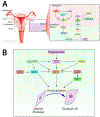90 YEARS OF PROGESTERONE: New insights into progesterone receptor signaling in the endometrium required for embryo implantation
- PMID: 31809260
- PMCID: PMC7261627
- DOI: 10.1530/JME-19-0212
90 YEARS OF PROGESTERONE: New insights into progesterone receptor signaling in the endometrium required for embryo implantation
Abstract
Progesterone's ability to maintain pregnancy in eutherian mammals highlighted this steroid as the 'hormone of pregnancy'. It was the unique 'pro-gestational' bioactivity of progesterone that enabled eventual purification of this ovarian steroid to crystalline form by Willard Myron Allen in the early 1930s. While a functional connection between normal progesterone responses ('progestational proliferation') of the uterus with the maintenance of pregnancy was quickly appreciated, an understanding of progesterone's involvement in the early stages of pregnancy establishment was comparatively less well understood. With the aforementioned as historical backdrop, this review focuses on a selection of key advances in our understanding of the molecular mechanisms by which progesterone, through its nuclear receptor (the progesterone receptor), drives the development of endometrial receptivity, a transient uterine state that allows for embryo implantation and the establishment of pregnancy. Highlighted in this review are the significant contributions of advanced mouse engineering and genome-wide transcriptomic and cistromic analytics which reveal the pivotal molecular mediators and modifiers that are essential to progesterone-dependent endometrial receptivity and decidualization. With a clearer understanding of the molecular landscape that underpins uterine responsiveness to progesterone during the periimplantation period, we predict that common gynecologic morbidities due to abnormal progesterone responsiveness will be more effectively diagnosed and/or treated in the future.
Keywords: decidualization; endometrium; isoforms; mediators; modifiers; nuclear receptor; progesterone; receptivity.
Conflict of interest statement
Declaration of interest
The authors declare that there is no conflict of interest that could be perceived as prejudicing the impartiality of this review.
Figures



Similar articles
-
Decreased epithelial progesterone receptor A at the window of receptivity is required for preparation of the endometrium for embryo attachment.Biol Reprod. 2017 Feb 1;96(2):313-326. doi: 10.1095/biolreprod.116.144410. Biol Reprod. 2017. PMID: 28203817 Free PMC article.
-
Uterine Epithelial Progesterone Receptor Governs Uterine Receptivity Through Epithelial Cell Differentiation.Endocrinology. 2020 Dec 1;161(12):bqaa195. doi: 10.1210/endocr/bqaa195. Endocrinology. 2020. PMID: 33099617
-
Role of nuclear progesterone receptor isoforms in uterine pathophysiology.Hum Reprod Update. 2015 Mar-Apr;21(2):155-73. doi: 10.1093/humupd/dmu056. Epub 2014 Nov 18. Hum Reprod Update. 2015. PMID: 25406186 Free PMC article. Review.
-
Particular functions of estrogen and progesterone in establishment of uterine receptivity and embryo implantation.Histol Histopathol. 2010 Sep;25(9):1215-28. doi: 10.14670/HH-25.1215. Histol Histopathol. 2010. PMID: 20607663 Review.
-
Illuminating the "Black Box" of Progesterone-Dependent Embryo Implantation Using Engineered Mice.Front Cell Dev Biol. 2021 Apr 7;9:640907. doi: 10.3389/fcell.2021.640907. eCollection 2021. Front Cell Dev Biol. 2021. PMID: 33898429 Free PMC article. Review.
Cited by
-
How Protein Methylation Regulates Steroid Receptor Function.Endocr Rev. 2022 Jan 12;43(1):160-197. doi: 10.1210/endrev/bnab014. Endocr Rev. 2022. PMID: 33955470 Free PMC article. Review.
-
GOLPH3 modulates expression and alternative splicing of transcription factors associated with endometrial decidualization in human endometrial stromal cells.PeerJ. 2023 Mar 20;11:e15048. doi: 10.7717/peerj.15048. eCollection 2023. PeerJ. 2023. PMID: 36967990 Free PMC article.
-
Progesterone Signaling in Endometrial Epithelial Organoids.Cells. 2022 May 27;11(11):1760. doi: 10.3390/cells11111760. Cells. 2022. PMID: 35681455 Free PMC article.
-
Thicker endometrium on hCG trigger day improves the live birth rate of fresh cleavage embryo transfer in GnRH-agonist regimen of normogonadotrophic women.Ann Transl Med. 2021 May;9(10):856. doi: 10.21037/atm-21-1922. Ann Transl Med. 2021. PMID: 34164490 Free PMC article.
-
Spatial definition of the human progesterone receptor-B transcriptional complex.iScience. 2022 Oct 10;25(11):105321. doi: 10.1016/j.isci.2022.105321. eCollection 2022 Nov 18. iScience. 2022. PMID: 36325049 Free PMC article.
References
-
- Al-Sabbagh M, Lam EW & Brosens JJ 2012. Mechanisms of endometrial progesterone resistance. Mol Cell Endocrinol 358 208–215. - PubMed
-
- Allen WM 1974. Recollections of my life with progesterone. Gynecol Invest 5 142–182. - PubMed
-
- Allen WM 2005. My life with progesterone. 1970 Am J Obstet Gynecol 193 1575–1577. - PubMed
-
- Allen WM, Butenandt A, Corner GW & Slotta KH 1935. Nomenclature of Corpus Luteum Hormone. Science 82 153. - PubMed
Publication types
MeSH terms
Substances
Grants and funding
LinkOut - more resources
Full Text Sources
Research Materials

